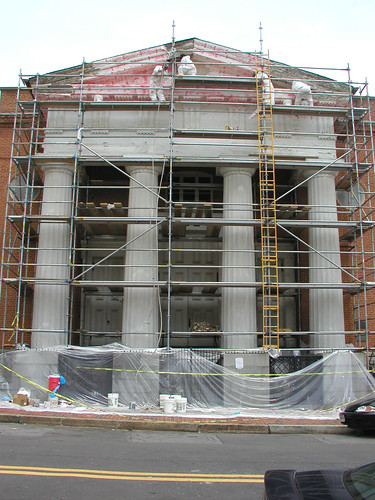Wednesday, August 20, 2008
From the desk of Avi Decter
Over its entire history of occupation and use as a house of worship (1845-c.1960), the LSS's brick body (as well as the exterior woodwork) was painted. The color schemes changed substantially over the decades, in keeping with changing fashion and taste and with the means of the several congregations who worshipped there.
At its dedication in 1845, the portico and the brick body of the building were painted "one uniform stone tint" (Isaac Leeser in The Israelite). When the building was expanded in 1860, the color of the portico and the brickwork was painted a pinkish-beige-grey (taupe) color; the window frames, window sash, and door frames were painted a dark brown, resembling brownstone; and the front doors were painted (grained) to resemble dark oak. This color scheme is documented in an 1864 photograph now in the JMM collection and substantiated by historic paint analysis.
In later periods, the exterior colors varied widely, and by 1958, the brick body was painted brick-red with white painted lines to simulate mortar lines - a paint scheme, in other words, designed to look like the underlying brick body! In 1963 - 64, the brick exterior was sandblasted, removing all the prior coats of historic paint (save for a few surviving fragments) - and destroying the glaze finish on the brickwork, as well.
In researching and planning for preservation work at the LSS, the JMM and its team of consultants (including a preservation architect, architectural historian, and historic paint analyst) have concluded that the best documented and most appropriate exterior color scheme, both from interpretive and preservation perspectives, would be to restore the exterior color scheme of the 1860s. This will comport well with the color scheme of the main sanctuary, which has been returned to c. 1871.
The change in exterior appearance may be startling to some observers, but its appearance in the past 44 years was a finish scheme that never was used throughout the building's 116 years as an active house of worship. The new color scheme now in progress will offer thousands of annual visitors a more authentic, accurate impression of a great Maryland landmark. Our decision, along with the historical documentation to support it, will be included in our interpretive tours and signage.
Painting the LSS
Tuesday, August 12, 2008
What's with all this scaffolding?
“The Jewish Museum of Maryland formally requests [Maryland Historic] Trust approval to restore the c. 1864 exterior color scheme and finishes of the historic Lloyd Street Synagogue (LSS). The structure that we see today from the outside of the building dates to 1860; the present exterior colors and finishes, however, date mostly to 1963-65, when the building was restored by the Jewish Historical Society of Maryland.” –
-------
Through extensive archaeological and archival research, we have discovered that appearance of the LSS has gone through extensive changes – almost from the very moment it was completed. “Throughout its history of occupancy and use by three successive immigrant congregations, 1845-1963, all or portions of the LSS’s brick exterior was painted; color schemes on the portico and stationary woodwork varied tremendously; the main (west) doors were grained repeatedly; and the stone foundation walls were at one point covered in stucco, colored and scored to resemble ashlar. In short, the LSS exterior as we see it today is neither accurate nor authentic to any of this landmark’s periods of historical or architectural significance!” (Decter).
During the restoration of the 1960s, the building was stripped of paint, sand blasted, cleaned, and repainted to what was assumed to be the original appearance. Very little of the original paintwork remained, but through the work of many professionals, including Garry Wheeler Stone, architectural historian, John Srygley, preservation architect, and Matthew Mosca, historic paint consultant, we have discovered many traces of the congregations that once occupied the LSS.
Since beginning archaeological investigations in the late 1990s, we have discovered many heretofore unknown attributes of the building, including the original mikveh, beautiful frescos, a matzah oven, and the base of what was probably a steeple. With the generous help from the City of
The LSS was the first synagogue to be built in
Monday, August 11, 2008
So it begins...
Pre-Restoration Lloyd Street Synagogue
 Image courtesy of Caruso Studios.
Image courtesy of Caruso Studios.This is how Lloyd Street Synagogue appeared in 1864. This is the oldest known image of the building, when it was still operated by Baltimore Hebrew Congregation.
 "Carte-de-visite" of the Lloyd Street Synagogue, circa 1864.
"Carte-de-visite" of the Lloyd Street Synagogue, circa 1864.Photo courtesy of the Ross J. Kelbaugh Collection.
JMM1997.071.001
This is the interior of LSS as it appears currently.






